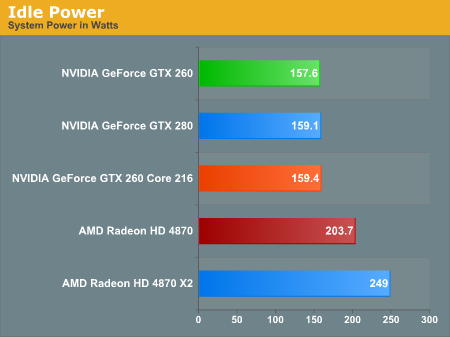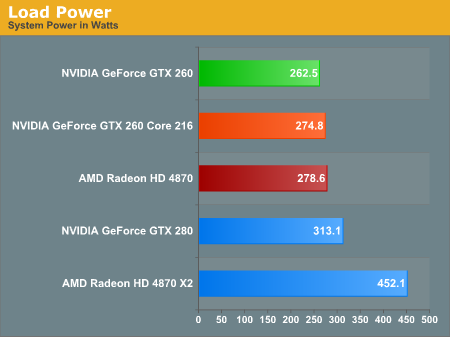
Original Link: https://www.anandtech.com/show/2619
NVIDIA GeForce GTX 260 Core 216: Competition for the 4870
by Anand Lal Shimpi & Derek Wilson on September 16, 2008 12:00 AM EST- Posted in
- GPUs
Nearly a year ago I wrote about something I called "sensible naming" with respect to GPUs. It was at the time of the Radeon HD 3800 series launch where AMD unveiled a much cleaner, simpler way of naming its cards. Gone were the suffixes (for the most part) and instead what we were left with was this:
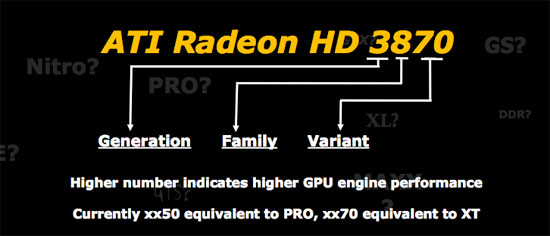
A family name, Radeon HD, followed by a four digit number. With the exception of the X2s, AMD has stuck to its naming system without fault. In fact, AMD has done such a good job with keeping the names clean that things are the way they should be: the internal codenames are more difficult to remember than the actual names of the cards (e.g. RV770 vs. Radeon HD 4870).
NVIDIA however, just hasn't gotten the hint. The GT200 launch gave us two simply named cards: the GeForce GTX 280 and GTX 260, but it didn't take long for NVIDIA to confuse the marketplace with the launch of the GeForce 9800 GTX+. I hoped that the naming silliness was limited to the older GeForce 9 GPUs, but today it extended into the GTX lineup.
It's called the GeForce GTX 260 Core 216.
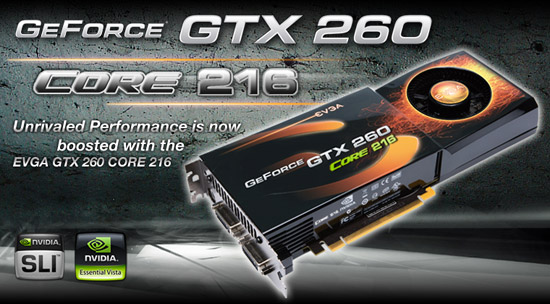
Holy nomenclature Batman
The GeForce GTX 260 Core 216's name is actually quite descriptive, albeit absurdly long. The GeForce GTX 260 part we already know from the GT200 launch, the Core 216 suffix just indicates that the GPU has 216 "cores" (also playing on Intel's new Core i7 naming for Nehalem, due out later this year). Why NVIDIA didn't just call it a GeForce GTX 265 or 270 is beyond me. To make matters worse, we'll see companies adding their own suffixes to the already extended name. For example, EVGA sent us their Core 216 called the EVGA GeForce GTX 260 Core 216 Superclocked Edition. Perhaps it's some conspiracy to increase the salary of writers who get paid by the word.
| GTX 280 | GTX 260 Core 216 | GTX 260 | 9800 GTX+ | 9800 GT | |
| Stream Processors | 240 | 216 | 192 | 128 | 112 |
| Texture Address / Filtering | 80 / 80 | 72/72 | 64 / 64 | 64 / 64 | 56 / 56 |
| ROPs | 32 | 28 | 28 | 16 | 16 |
| Core Clock | 602MHz | 576MHz | 576MHz | 738MHz | 600MHz |
| Shader Clock | 1296MHz | 1242MHz | 1242MHz | 1836MHz | 1500MHz |
| Memory Clock | 1107MHz | 999MHz | 999MHz | 1100MHz | 900MHz |
| Memory Bus Width | 512-bit | 448-bit | 448-bit | 256-bit | 256-bit |
| Frame Buffer | 1GB | 896MB | 896MB | 512MB | 512MB |
| Transistor Count | 1.4B | 1.4B | 1.4B | 754M | 754M |
| Manufacturing Process | TSMC 65nm | TSMC 65nm | TSMC 65nm | TSMC 55nm | TSMC 55nm |
| Price Point | $420 - $500 | $279 | $250 - $300 | $200 | $130 - $170 |
If you remember the diagram below from our GT200 review you'll see that a GeForce GTX 280 has ten clusters of 24 stream processors (the little blue blocks), for a total of 240 SPs or "cores". The GeForce GTX 260 has eight of those clusters (called Texture/Processor Clusters or TPCs), bringing its total up to 192 SPs. The Core 216, as you can guess, has nine clusters or 216 SPs. NVIDIA just enabled another TPC on the Core 216 (or alternatively, disabled a TPC on a GTX 280).
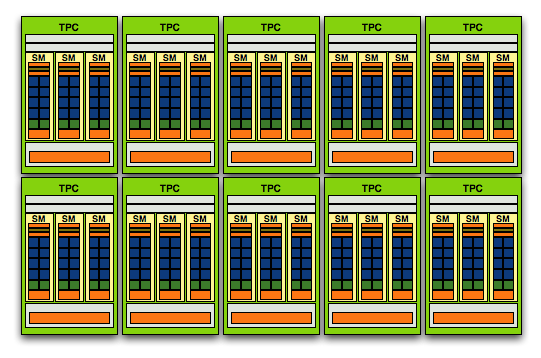
The GeForce GTX 280, 10 TPCs, 240 SPs
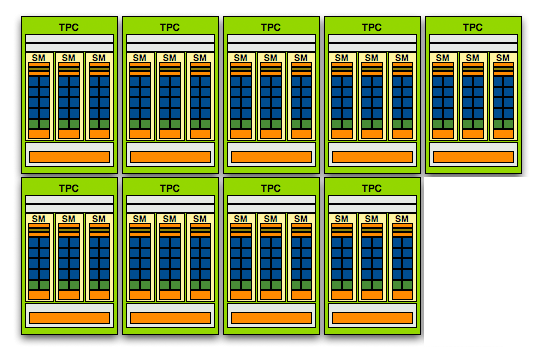
The GeForce GTX 260 Core 216, 9 TPCs, 216 SPs
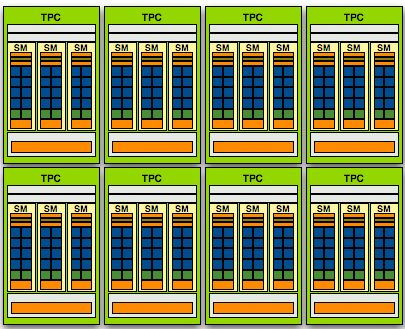
The GeForce GTX 260, 8 TPCs, 192 SPs
The extra TPC also gives the Core 216 another 8 texture address and filtering units, but the rest of the chip's makeup remains the same, even down to the clock speeds. The Core 216 runs its core, shader and memory clocks at the same frequencies as the vanilla GTX 260.
Priced at $279, the Core 216 is a direct competitor to AMD's Radeon HD 4870 - selling at a similar price. The GTX 260 will continue to exist although selling at a cheaper price point and naturally with more processing power, the GTX 280 remains unaffected.
EVGA's GeForce GTX 260 Core 216 Superclocked
In North America there are only two vendors launching a Core 216 today: EVGA and BFG. We're not sure what this will mean for street pricing and availability but it is what it is.
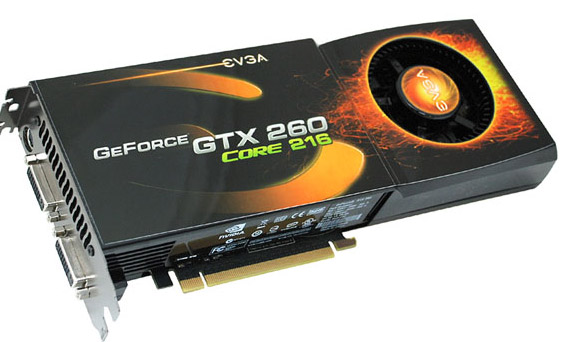
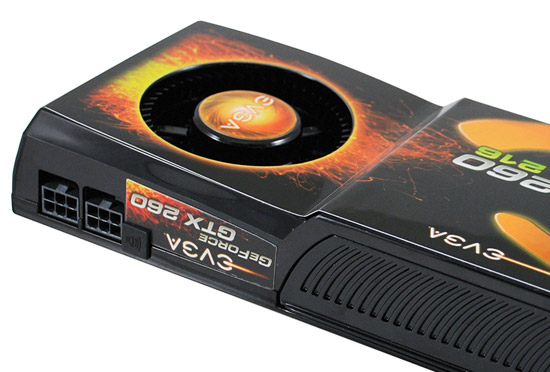
EVGA sent us one of their Core 216 cards, the GeForce GTX 260 Core 216 Superclocked. As the name implies, the Superclocked version will ship overclocked:
| GeForce GTX 260 Core 216 (stock) | EVGA GeForce GTX 260 Core 216 Superclocked | |
| Core Clock | 576MHz | 626MHz |
| Shader Clock | 1242MHz | 1350MHz |
| Memory Clock | 999MHz | 1053MHz |
| Price Point | $279 | $299 |
The factory overclocked nature of the card means that EVGA will charge a bit more for it, $299 to be specific. For this comparison we've tested the Core 216 at its stock clock speed, but the chart below shows the sort of performance advantage EVGA's overclock gives it:
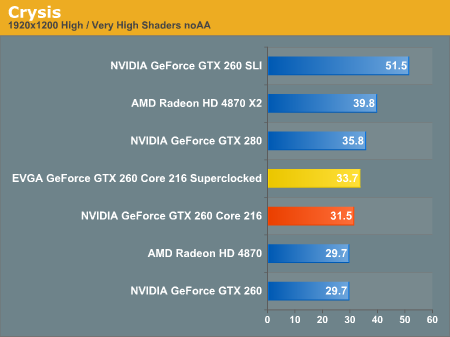
We're looking at a 7% increase in performance here for an extra $20. Chances are that you'll be able to pull off something close to this overclock on your own so we'd recommend sticking with a stock card especially given how close the Core 216 vs. 4870 is, as you'll soon see.
The Test
| Test Setup | |
| CPU | Intel Core 2 Extreme QX9770 @ 3.20GHz |
| Motherboard | EVGA nForce 790i SLI |
| Video Cards | ATI Radeon HD 4870 X2 ATI Radeon HD 4870 NVIDIA GeForce GTX 280 NVIDIA GeForce GTX 260 SLI NVIDIA GeForce GTX 260 NVIDIA GeForce GTX 260 Core 216 |
| Video Drivers | Catalyst 8.7 ForceWare 177.34 |
| Hard Drive | Seagate 7200.9 120GB 8MB 7200RPM |
| RAM | 4 x 1GB Corsair DDR3-1333 7-7-7-20 |
| Operating System | Windows Vista Ultimate 64-bit SP1 |
| PSU | PC Power & Cooling Turbo Cool 1200W |
Age of Conan
The Radeon 4870 leads its competition here. While the GTX 260 Core 216 does edge closer to the GTX 280, the Radeon 4870 is just an excellent performer in this test.
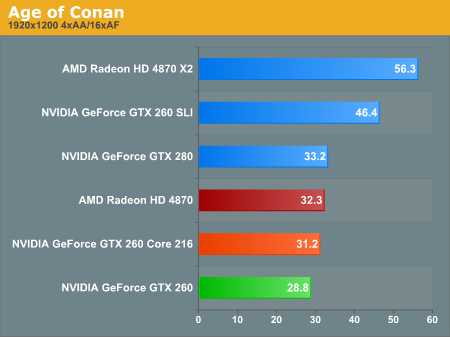
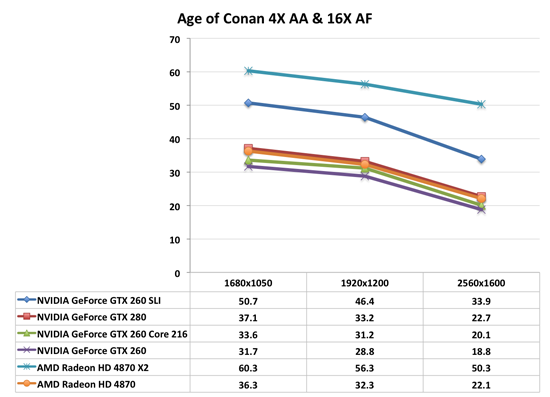
Crysis
While the GTX 260 tied the 4870 in this benchmark, enabling the additional TPC does allow the GTX 260 core 216 to pull ahead by a little more than 6% at 1920x1200. The absolute difference in performance is just under two frames per second, and honestly either a lower resolution or lowered settings for Crysis are in order for real smooth game play.
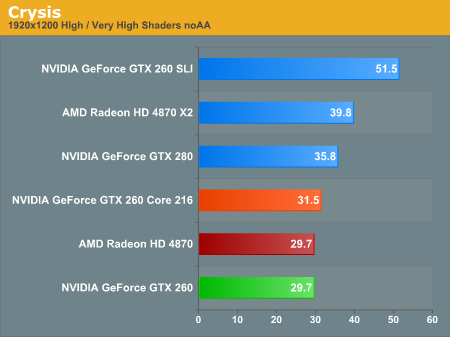
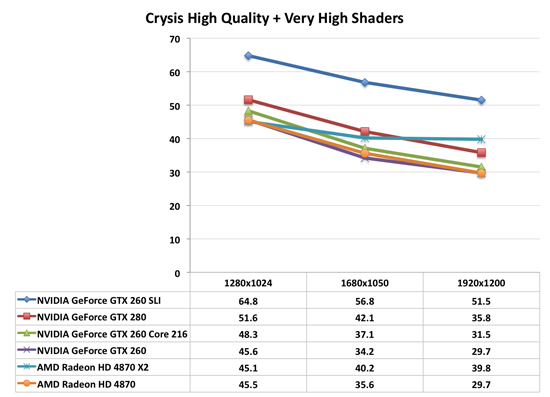
Enemy Territory: Quake Wars
With our ET:QW bench, at 2560x1600, the Core 216 adds enough horse power to pull the NVIDIA card up to a tie with the 4870. Yes, there is a tenth of a frame difference here, but that's well within margin of error.
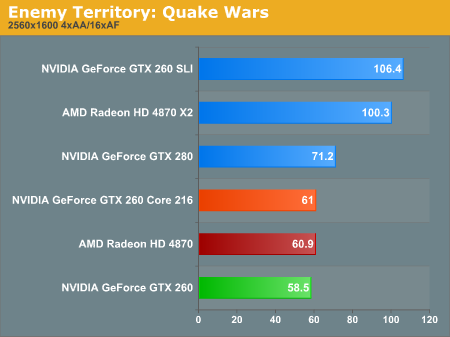
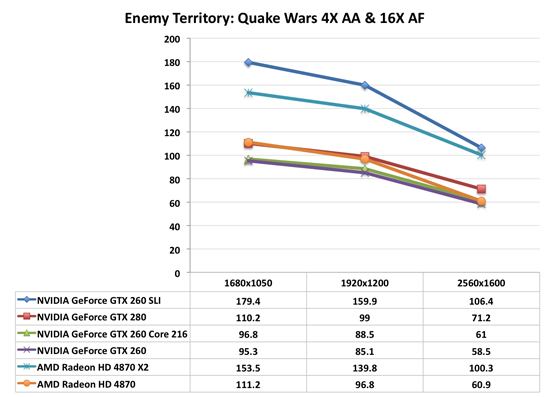
Oblivion
The GTX 260 already had the advantage here, so the GTX 260 core 216 just extends the lead at every data point. Even at the highest resolution, Oblivion remains playable on all cards, as it is pretty resilient to lower frame rates.
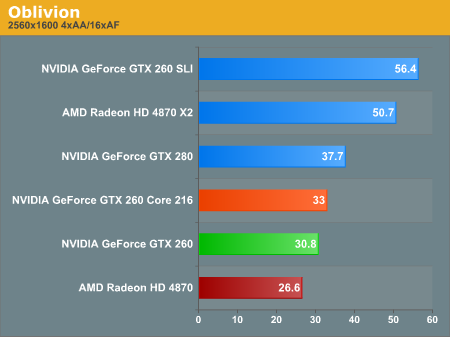
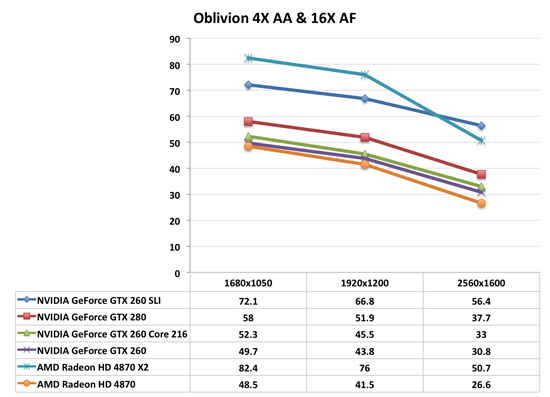
Race Driver GRID
Not surprisingly, the Radeon 4870 tears up the GTX 260 core 216 in GRID. This is one of the games where the AMD card not only leads at it's price point, but beats the GTX 280 as well. This is a very impressive lead for the AMD part, but we can't put all our eggs in this basket either.
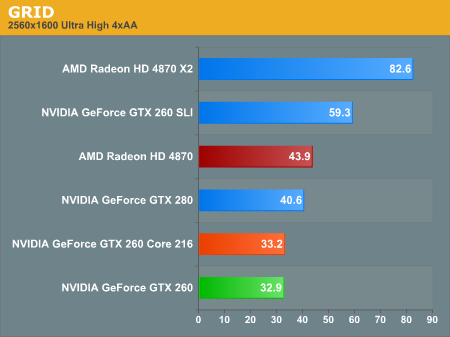
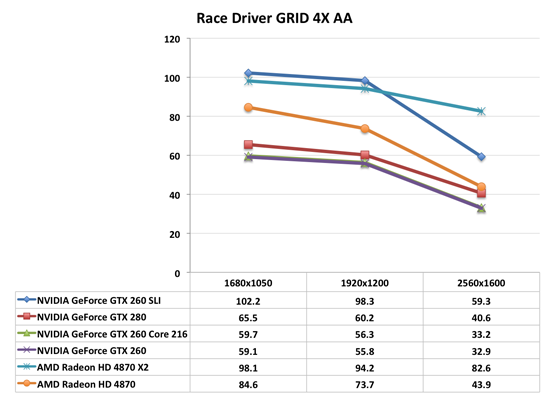
Assassin's Creed
NVIDIA's new part does make some performance gains on the 4870, but just isn't quite able to catch up. The AMD card still leads on this one.
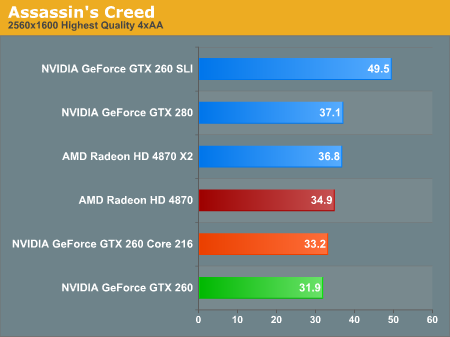
The Witcher
The core 216 adds enough power to pull ahead in our test of The Witcher. In addition to Crysis, the results of this test change with the introduction of the new hardware. But it's still a very close result.
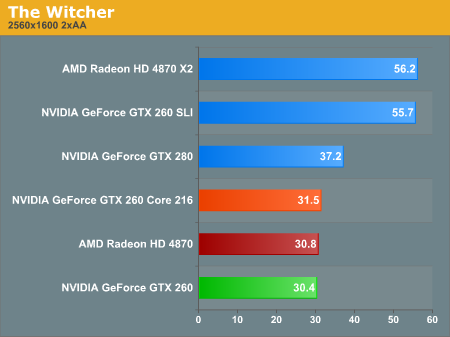
Power Consumption
While idle power is roughly the same as the GTX 260, load power does increase a little bit. Keep in mind that we did underclock an EVGA Superclocked Edition of this card for these tests. If EVGA set voltages higher on this part than they would on stock clocked hardware, we might be seeing an increase in power consumption due to this.
What we can say is that we think this is a good picture of worst case power consumption increase from a GTX 260 to a GTX 260 core 216. This is not a bad thing, as the GTX 260 core 216 does draw less power than the Radeon 4870 under load and at idle.
Final Words
We tested seven games. AMD and NVIDIA split it, each winning three of them and virtually tied in the seventh. I hate to disappoint those looking for a one sided fight here, but this one is a wash. NVIDIA would want to point out that CUDA and PhysX are significant advantages that would put the Core 216 over the top but honestly there's no compelling application for either (much like the arguments for Havok and DirectX 10.1 from the AMD camp).
Our recommendation here is to first see if either card happens to run a game you care about better than the other, but if not then just buy whatever is cheaper. Today that would be the Radeon HD 4870, currently it's very tough to find stock-clocked Core 216s and those are priced above $300; even if we could find availability at $279, the 4870 is still cheaper. Until the price comes down, the Radeon HD 4870 still remains our pick at the $250 - $300 pricepoint. While NVIDIA has closed the performance gap, the part they used still maintains a price gap.
NVIDIA says they will have availability on the silicon but that only two manufacturers are going to have parts out of the gate on this, which does give us pause. If the GTX 260 had been originally released with 9 TPCs (216 SPs), then it would have been a better competitor to the Radeon HD 4870 and we wouldn't need this slight tweak of a readjusted part. It doesn't generally deliver near it's 12.5% maximum theoretical performance improvement, and really seems like its only a thinly attempt to win at a couple more benchmarks than usual.
Yes it does that, and yes the consumer does benefit even if the benefit is ever so slight. But what none of us benefit from is an over abundance of parts released at nearly the same price point with nearly the same name and nearly the same specs. NVIDIA really needs to stop this trend. ATI tried this a few generations ago, but thankfully (at least since the AMD merger) they seem to have cleaned up their act a bit. There is no reason to have a continuum of hardware with increasingly complex naming as the gaps between parts are filled in.
What we need is less confusion in the market place and a focus on fairly pricing competitive hardware. Trying to get around supply and demand by cluttering up the market with different parts that have similar names and slightly different pricing isn't a consumer friendly way to go.

